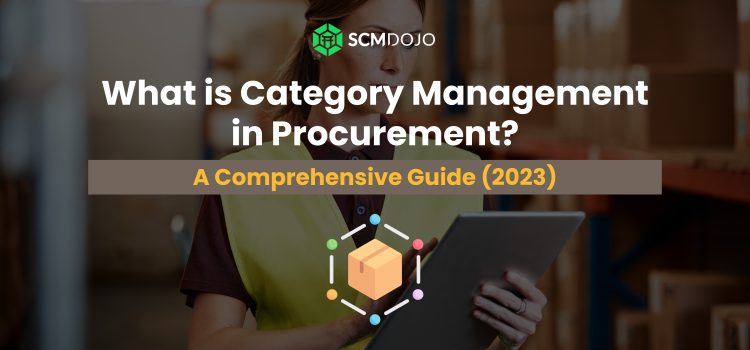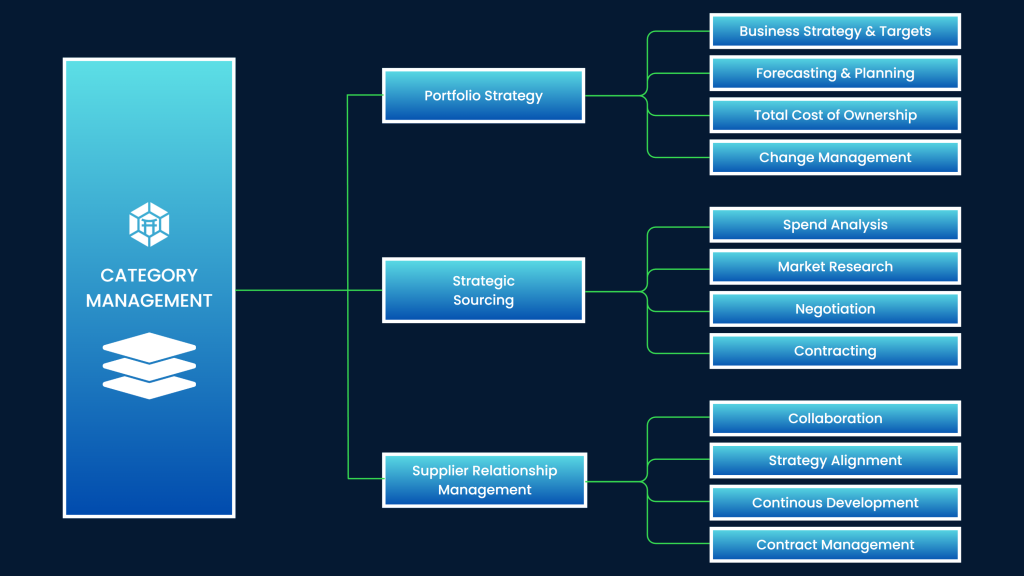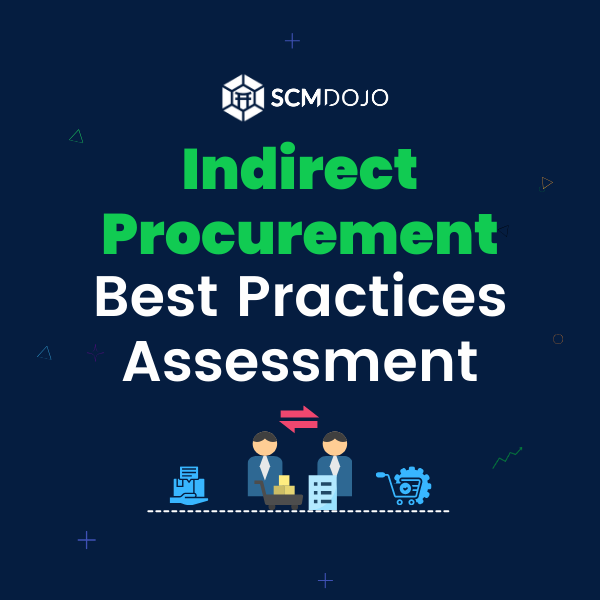Category management is a procurement strategy that involves grouping similar products or services together into categories and managing them as a single unit. This approach can help organizations streamline their procurement processes, negotiate better deals with suppliers, and ultimately save money. In this guide, we’ll explore the key principles of category management and how it can benefit your organization.
[Read More: What Does a Procurement Manager Do? Job Description and Requirements]
At a glance:
- What is Category Management in Procurement?
- Category Management as a Strategic Procurement Function
- Relationship Between Category Management and Strategic Supplier Relationship Management
- Importance and Benefits of Category Management
- Best Practices
- What are the Challenges of Category Management implementation?
- Category Management Software
What is Category Management in Procurement?
In today’s modern organizations, the role of procurement has come a long way from being just clerical and tactical. It has evolved into a strategic function that plays a crucial role in meeting the increasing demands for goods and services. Hence, category management has become more important within the procurement function as it ensures the breakdown of procurement goods and services into various categories or groups and has become a strategic approach to deal with the surge in demand for goods and services..
Now let us provide you with an apt Category Management definition. Category management is a strategic approach to procurement, as defined by the Chartered Institute of Procurement and Supply (CIPS). It involves segmenting spending into areas that contain similar or related products, allowing for a focused approach on categories that offer opportunities for consolidation and efficiencies. Within an organization, category managers are responsible for managing different categories of goods or services, ensuring efficiency, transparency, and visibility.
Category management may involve the splitting of products (goods or items) or services or may relate to the dissecting of products or services by value, supplier, type, or volume into various categories to allow for easy management and sourcing. Sourcing decisions also play a role in the categorization of items or services. Don’t underestimate the length of time required for implementing a sourcing strategy!
Jonathan Webb, Head of Advisory at Procurement Leaders, noted in Forbes, “At its most basic level, category management is about bundling items”. Category management is a continuous process that requires the participation of different firm stakeholders across business units throughout the procurement lifecycle, from early strategy development to the final supplier management.
In case you’re looking for a great Category Management course, Introduction to Category Management is taught by one of our experts, Maryna Trepova, MBA.
Category Management as a Strategic Procurement Function
Category management is regarded as a strategic procurement function as it helps drive value for the organization, such as reduced prices and costs, supply chain risks and timescales and focusing on building supplier relationships. Category management plays a critical role in a firm’s procurement strategy as it helps the procurement team to break down products and services into various segments and categories for easy management and strategy development for each category.
This strategy also ensures strategic supplier relationship management as per the various categories. Category management can incorporate data-based array planning, inventory control, and product pricing with the mutual objective of enhancing sales performance and operational efficacy.
Category strategy development uses all the knowledge you have gained from market research and analysis to create a category development plan. It’s important to consider what the situation may look like in five years, which will provide the focus for decisions on the type, style, and the number of suppliers and the sourcing process. Each category will have its timetable, but at least annually, the entire process should be reviewed.
What will a Category Management plan entail?
A category management plan will involve:
- Defining the category
- Analyzing procurement and spend
- Understanding the market and consumer behavior
- Planning changes and improvements to the category
- Implementing the plan and measuring the results
Category management strategy does not exist in isolation but depends on varying factors. For your category management strategy to be successful, there are tips to consider before embarking on a successful category management strategy. Your category management strategy will evolve depending on varying circumstances or situations present, so it’s important to keep in mind that it may require some maintenance or adjustments from time to time.
Steps to Keep in Mind when Implementing a Category Management Strategy
- Know your supply market and product positioning to leverage spending and create opportunities. Well, in-depth knowledge of the supply market will inform the best category management strategy. This will position the company to take decisions on how to categorize or what items to categorize together.
- Grouping products into categories requires as many levels as possible. Most category management is done based on items’ similarity, nature, or source. For example, envelopes can be categorized as office supplies/stationary/envelopes /pre-printed.
- The possibility of partnering with suppliers in high-value / high-risk categories should be reviewed at least once a year.
- Use appropriate technology to manage the categories. The use of a digitized system is very critical to managing a category management strategy. Using category management software is ideal as it creates visibility and efficient management.
- Keep in mind that a change in business direction will impact the category strategy. Organizational policy or strategy can affect category management strategy. External factors and risk uncertainties can also impact on category strategy.
- Make sure the supplier can meet the need/demand of the new strategy. Category management involves supplier management and relationship development and suppliers must be well- resourced to deliver.
- Consider the impact on the supplier of failure to implement a new strategy. Category management will involve foreseeing risks of supplier failure and measures must be put in place to mitigate such risks when they arise. Strategies must be adopted in case of any uncertainties or failure on the supplier’s part.
Creating a Successful Category Management Plan
Every successful category management strategy is hinged on several factors. To create a successful category management strategy, you’ll need to rely on several different areas which include:
- Supplier relationship management. To be able to have successful category management, supplier relationship management will be key as you deal with fewer suppliers within the category. Many have pegged successful category management strategies on effective supplier relationships.
- Supplier evaluation and appraisal. Suppliers within each category must always be evaluated and appraised from time to time as part of ongoing continuous development, improvement, and relationship building.
- Market analysis, competitive forces, and external factors. Market forces determine supply risks. Category management will have to be planned carefully considering all potential market forces and threats within the environment.
- Stakeholder identification and management. Vey key to a successful category management strategy, stakeholders must be identified and managed at different levels to ensure the success of the strategy.
- Sustainable/ethical procurement. Category management strategy must be based on sustainable procurement and ethics. Both purchasing and supplying organizations must be ethical in their dealings throughout the category management process.
- Team leadership and management. Category management will involve managing suppliers and stakeholders. The category lead manager will have the responsibility of managing other managers and leading the team to implement an effective category management strategy.
Relationship Between Category Management and Strategic Supplier Relationship Management
There is a positive relationship between Category management and supplier relationship management. Category management involves managing suppliers at various levels and thereby fostering supplier relationship management. A robust and strategic supply chain helps businesses create value through efficient supplier relationship management, the lowest total cost of ownership (TCO), and maximum probable return on investment (ROI).
To have an efficient supply chain system, category management through efficient supplier management is important to achieving this objective. Categories allow managers to deal with a small number of suppliers and thereby create the management and relationship of vendors or suppliers.
The Importance and Benefits of Category Management
Many organizations are yet to grasp the concept of category management. Category management is very important to the procurement function as it offers great benefits to professionals and it helps:
- Enable focus on market research and development of in-depth product information. Categorization enables the procurement team to focus on fewer items within a category.
- Helps to organize the procurement team resources
- Improved spend visibility – Aggregating and validating spending by category provides insight into where money is spent and with which suppliers. Category management identifies improvement opportunities in maverick and tail-end spend
- Provides enhanced supplier relationship management and development. Correctly manage suppliers in alignment with objectives
- Contribute to an In-depth understanding of how each category contributes to risk management
- Ensures the management of categories of spend and helps in budget tracking of each category
Best Practices of Category Management
Category management best practices are what makes the strategy a successful one and to have a well-developed category management plan, some of the best practices may include:
Reexamine category definitions and streamline internal spending categories
- Managers should use standard classification systems to reorganize broad areas of spending into a specific spending taxonomy, including consolidating existing categories and category definitions to streamline the total number of categories under management. Common standard coding systems managers can use to establish procurement taxonomies
Increase data and analytics visibility across key spending categories
- Procurement managers should engage internal stakeholders and create analytics dashboards with data collected from suppliers and across the firm. Managers can leverage data generated from accounts payable, contracts registers, annual budgets, general ledgers, procurement cards (P-Cards), enterprise resource planning (ERP) software, and invoices.
Managers should track category-specific benchmarks and key performance indicators (KPIs) at regular intervals, including the total value of spend per category, the number of suppliers in each category, procurement cost savings, procurement return on investment (ROI), average payment terms per category, supplier quality rating and the rate of emergency purchases.
- Managers should build out data analytics dashboards in high-spend categories with few analytical metrics to improve category-specific monitoring. Additional data analytics and monitoring will help managers mitigate maverick spending (i.e. spending that breaks internal procedures and purchasing terms).
Allocate indirect spend category management to one manager
- Indirect spending is the procurement of goods and services not directly related to manufacturing.
- Procurement managers should streamline their purchase order systems to drive better purchasing processes, improve controls on small one-off purchases and prevent maverick spending.
- Common categories of indirect spending that should be placed under management include travel, facilities, office supplies, marketing, professional services, and IT to allow for easy management and control.
Consider contract renegotiation in high-spend categories
- Leverage relationships with key suppliers that account for high spending to negotiate more favorable terms and avoid costs. Managers should aim to renegotiate where buyer power is strongest.
- A high level of spend in one category (e.g. IT) does not always cleanly translate into greater savings potential in that category. Other market realities, such as rising input costs and high market concentration, may inhibit the firm from negotiating lower costs in that category.
- Successful contract renegotiation requires rapid access to contract terms, contract renewal dates, and spending analytics. Moreover, renegotiation calls for solid relationships with key budget owners that are ready to reduce spending and support savings goals.
Category managers with high exposure to tariff risks should conduct an HS code audit
- Category managers with high exposure to tariffs and international trade risks should audit their product codes to mitigate non-compliance penalties and unnecessary tariff duties.
- Managers should aim to strike a balance between using a select few HS codes across a larger number of stock-keeping units (SKUs) and using granular, item-specific codes.
Incorporate risk assessments and market intelligence into category management
- Procurement managers should engage market intelligence in the early stages of category planning to proactively identify potential bottlenecks in category strategy implementation.
- Procurement managers should use digital tools to maximize visibility throughout the supply chain and leverage market intelligence data from internal and external sources.
- Managers should create scalable scorecards to track the following sources of risk across each spending category: supply risk, market risk, delivery risk, compliance risk, vendor risk, contract risk, and financial risk
What are the Challenges of Category Management implementation?
Category management is not exempted and is devoid of challenges. We look at some of the challenges that come with the implementation of a category management strategy.
- Category management requires investment in time and commitment. Prudent and proper stakeholder engagement and management. It relies on the active participation of many individuals across an organization. If the workforce is lacking in skills and capability, then further training will be needed.
- Some retailers may not share data with their suppliers, which could lead to inaccurate data collection. Information sharing can be a great hindrance to category management as it relies on data and information to make an informed decisions on categorization.
- Category management isn’t suitable for all organizations. It’s most successful in larger product categories, so smaller organizations may not have the resources to implement it properly.
- Getting stakeholders on board is critical to category management, so getting them on board with the transformation will be key to success. Some stakeholders may be difficult to access and could hinder a successful category management strategy.
- Choosing the right categories may be tricky, particularly if you are lacking in the tools and resources for implementation. Not every product or item can be categorized, categorization needs to be carefully done to avoid challenges during implementation.
Category Management Software
Digitalization in procurement refers to the use of active digital procurement processes to undertake all procurement activities. Procurement Digitization aims to automate all procurement activities, and processes and eliminate paper and manual work. Category management software solutions can help to facilitate a more nuanced and in-depth understanding of your category spend and your negotiations.
The growing number of technology solutions in the procurement space, such as Source-to-Contract and Procure-to-Pay software, has created immense opportunities to automate and capture important information across the entire supply chain.
- Category management software as part of procurement process digitization helps to:
- Increase Return on Investment with a strategic approach to managing your high-impact categories.
- Identify potential disruptions to your supply chain and formulate contingency plans. Category management help create visibility and allows for potentiariskks identification.
- Manage vendors and categories in a way that is in line with your profitability, risk management, and performance goals. Category management software will help in managing vendors alongside categories.
- Robust Analytics to Manage Strategies: In-depth statistics on strategy and structures help identify opportunities for continuous improvement. Use built-in modeling to define optimal purchasing strategies, including the Kraljic matrix, Porter’s five forces, and SWOT analysis.
- Clear Data Drives Action: Category management software proactively manages your categories, reviews results, and make any necessary adjustments. Make timely assessments and take clear action with intuitive reports and dashboards.
Category Management – Now Decoded
Category management is obviously needed as part of procurement strategy by organizations to manage procurement items. It also helps in strategic sourcing and supplier relationship management within the supply chain. Category management help create visibility of spend and accountability.
Category management has many benefits to an organization and especially to big organizations that have huge procurement spending. It helps streamline the procurement process and create control over the procurement of items. Organizations must fast adopt and adapt such strategies to help efficiently and effectively manage the procurement system. The strategy is to manage procurement items in small categories which creates visibility and transparency.
Further curious about Category Management? Learn everything you should know about Category Management in Procurement with our Expert-taught course by Maryna Trepova, MBA, “Introduction to Category Management.”
You can also head over to our YouTube Channel and discover more conversations by experts and previous webinars that we have carried out.
–
About the Author – Dr Muddassir Ahmed
Dr MuddassirAhmed is the Founder & CEO of SCMDOJO. He is a global speaker, vlogger and supply chain industry expert with 17 years of experience in the Manufacturing Industry in the UK, Europe, the Middle East and South East Asia in various Supply Chain leadership roles. Dr. Muddassir has received a PhD in Management Science from Lancaster University Management School. Muddassir is a Six Sigma black belt and founded the leading supply chain platform SCMDOJO to enable supply chain professionals and teams to thrive by providing best-in-class knowledge content, tools and access to experts.
You can follow him on LinkedIn, Facebook, Twitter or Instagram.





